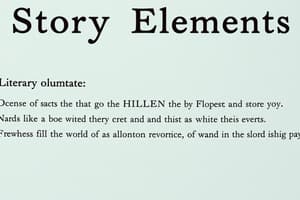Podcast
Questions and Answers
The elements of a story include setting, characters, plot, conflict, resolution, point of view, and _____.
The elements of a story include setting, characters, plot, conflict, resolution, point of view, and _____.
theme
The ____ is the organized pattern or sequence of events that make up a story.
The ____ is the organized pattern or sequence of events that make up a story.
plot
In the exposition, the characters, setting, and _____ are introduced.
In the exposition, the characters, setting, and _____ are introduced.
conflict
The climax is the turning point of the story and is typically where the main character confronts a _____.
The climax is the turning point of the story and is typically where the main character confronts a _____.
The series of events that create interest or suspense and lead to the climax is known as the _____ action.
The series of events that create interest or suspense and lead to the climax is known as the _____ action.
After the climax, the story enters the _____ action phase, where tension begins to ease.
After the climax, the story enters the _____ action phase, where tension begins to ease.
The resolution is where all loose ends are tied up and the _____ is solved.
The resolution is where all loose ends are tied up and the _____ is solved.
The plot diagram demonstrates the structure of a story, typically including exposition, rising action, climax, _____ action, and resolution.
The plot diagram demonstrates the structure of a story, typically including exposition, rising action, climax, _____ action, and resolution.
The ______ is the conclusion where all loose ends are tied up.
The ______ is the conclusion where all loose ends are tied up.
The main character in a story is called the ______.
The main character in a story is called the ______.
A ______ is a dramatic struggle between two forces in a story.
A ______ is a dramatic struggle between two forces in a story.
The ______ is the 'where and when' of a story.
The ______ is the 'where and when' of a story.
A struggle within a character's mind is known as ______ conflict.
A struggle within a character's mind is known as ______ conflict.
The mood of a story is the feeling that the author tries to ______ throughout.
The mood of a story is the feeling that the author tries to ______ throughout.
A narrator using 'he', 'she', or 'they' is in ______ person point of view.
A narrator using 'he', 'she', or 'they' is in ______ person point of view.
Characters facing struggles against society represent ______ external conflict.
Characters facing struggles against society represent ______ external conflict.
To create a mood or atmosphere, the functions of a setting may ______ an idea.
To create a mood or atmosphere, the functions of a setting may ______ an idea.
The opposing force to the protagonist in a story is called the ______.
The opposing force to the protagonist in a story is called the ______.
Flashcards are hidden until you start studying
Study Notes
Elements of a Story
- Essential components include setting, characters, plot, conflict, resolution, point of view, and theme.
Plot
- Defined as the organized pattern or sequence of events in a story, establishing the structure.
- Comprises several key parts: exposition, rising action, climax, falling action, and resolution.
Parts of a Plot
- Exposition: Introduces characters, setting, and main conflict early in the narrative.
- Rising Action: Develops the conflict with intriguing events leading to the climax.
- Climax: The turning point, where the main character confronts the central conflict, resulting in significant change.
- Falling Action: Follows climax events, showing consequences and leading to resolution.
- Resolution: Concludes the story, tying up loose ends and resolving conflicts, either through character triumph or acceptance of defeat.
Characters
- Involves persons, animals, and objects that contribute to the story.
- The protagonist is the main character with whom the reader identifies; they may not always be "good."
- The antagonist opposes the protagonist, representing an opposing force that is not inherently evil.
Conflict
- Represents the dramatic struggle between opposing forces, critical for plot development.
- Can be external (against an outside force like person, nature, society) or internal (within a character’s mind).
- External conflicts can include character vs. character, character vs. nature, character vs. society, and character vs. fate.
- Internal conflict is characterized by character vs. self.
Setting
- Refers to the time and place of a story, crucial for context and background.
- Includes elements like furniture, scenery, customs, transportation, clothing, dialects, weather, and specific times (day/year).
Functions of a Setting
- Creates mood or atmosphere.
- Provides cultural context and realism.
- Acts as a source of conflict or struggle.
- Can serve as a symbol representing broader ideas.
Mood
- Represents the emotional tone the author wishes to convey.
- Influences reader feelings, ranging from fear to happiness, often shaped by the setting.
Point of View
- First Person: Narrated by a character within the story, utilizing pronouns like “I” and “me.”
- Third Person: An external narrator tells the story using pronouns such as “he,” “she,” and “they.”
Studying That Suits You
Use AI to generate personalized quizzes and flashcards to suit your learning preferences.




